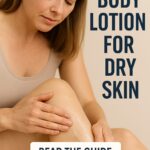
Aging body skin is usually drier, thinner, and less springy than it used to be. Showers, indoor heating, and friction from clothing speed up water loss and make crepey texture more visible on arms, chest, and shins. The fix is not one magic bottle. You will get the best results by pairing daily barrier support with targeted renewers a few nights per week. That means humectants to pull in water, emollients to soften the surface, and just enough occlusive to slow moisture drift without leaving a greasy film. On top of that base, ingredients like lactic acid or retinol can gently improve the look of tone and fine lines over time. Use this guide to pick a bottle that matches your main goal today, then follow the routine below to keep comfort and glow steady all season.
This guide is part of our Best Body Lotion hub where you can jump to options for dry, sensitive, eczema-prone, and glowing skin.
Quick Picks + Comparison
Aging concerns vary, so these four cover distinct jobs: crepe-smoothing, overnight retinol care, texture renewal, and daytime firming. Start with the one that matches your top priority, then add a second texture for night or for warmer months.
| Our pick | Why it’s great | Texture & key highlights | Best for |
|---|---|---|---|
| Gold Bond Age Renew Crepe Corrector | Cushions crepey look with humectants and emollients that leave a soft, non-greasy finish | Medium cream; glycerin, lipids, smoothing polymers | Arms, chest, and knees that look crinkly or paper dry |
| Olay Retinol Body Lotion (Night) | Gentle retinol blend plus moisturizers for overnight tone and smoothness | Light cream; retinoid + niacinamide feel | Nightly smoothing without a heavy film |
| AmLactin Daily 12% Lactic Acid | Lactic acid draws water and loosens flakes for a fresher surface | Creamy lotion; 12% AHA humectant-keratolytic | Dull, rough texture and KP-style bumps on arms |
| NIVEA Skin Firming & Toning Q10 | Fast daytime hydration with a subtle, tighter feel after consistent use | Light lotion; Q10 + vitamin C feel | Quick morning layer for arms and legs under clothes |
Ratings reflect a summary of owner feedback and stylist commentary.
Deep dives on the picks
Gold Bond Age Renew Crepe Corrector
Crepey texture shows when skin is both dry and thin. This cream targets the look of that crinkle by loading water into the upper layers while softening the surface so light reflects smoothly. The feel is cushioned without waxy residue, which is why it works well on forearms and the delicate chest area under tops. Apply a quarter-size per limb within three minutes of toweling off and give it two minutes to settle before dressing. If elbows or knees still look papery, press a pea-size on those zones at night for an extra seal. Many owners notice skin looks less “shriveled” in photos after a week of steady use, especially when they keep showers warm instead of hot.
Olay Retinol Body Lotion (Night)
If your main goal is a smoother look over time, this retinol body formula is a friendly entry. The texture is a light cream that spreads fast and dries down clean, so you can use it nightly without feeling sticky. Retinoids work slowly but steadily, which makes them well suited to arms and thighs that need more than moisture. Start three nights per week, then build to nightly as skin tolerates. Keep your morning routine gentle and use body sunscreen on exposed skin, since fresh, well-hydrated skin can be more sun sensitive. Expect the best results when you pair this at night with a simpler, fragrance-free lotion in the morning.
AmLactin Daily 12% Lactic Acid
Rough, dull skin often needs a gentle chemical polish, not a scrub. Lactic acid is both a humectant and a keratolytic, so it attracts water while loosening stubborn flakes. That two-for-one effect is why AmLactin is a classic for arms, shins, and heels that never look truly smooth. The lotion feels creamy and workable, and the finish is soft rather than greasy. Start every other night on target areas, then increase as comfort allows. On nights you use AmLactin, skip physical scrubs. Follow with a simple cream if you want more cushion. With steady use, many people see a clearer, more even surface in 1 to 2 weeks.
NIVEA Skin Firming & Toning Q10
For daytime, you may want hydration that dries fast, plays nicely under clothing, and leaves skin looking a touch tighter. This light lotion fits that job with a quick-dry feel and a subtle toning effect with regular use. It is not a miracle firming treatment, but as a daily morning layer it keeps arms and legs comfortable without shine. Because the texture is thin, it layers well under sunscreen on exposed areas. If your nights belong to retinol or lactic acid, keep this as your simple morning companion to maintain comfort while active ingredients do their slow, steady work.
What to look for in an aging-skin lotion
Pick texture by time of day. Choose a fast-dry lotion for morning and a cushier cream for night so you get comfort without stickiness. Seek humectants like glycerin to plump, emollients such as shea or triglycerides to soften, and just enough occlusive to keep moisture in. If crepe is your main worry, look for polymers and lipids that leave a smooth film. If dullness and rough patches steal glow, add lactic acid a few nights per week in place of scrubs. If tone and fine lines bother you most, rotate a gentle retinol body formula at night and give it weeks, not days. Keep fragrance low on full-body applications, especially after shaving. Last, match bottle formats to where you apply most. Pumps are great for arms and legs. Jars make it easier to scoop the right dose for heels and elbows.
A simple routine that works
Morning is for comfort and protection. After bathing, apply a light lotion within three minutes while skin is warm and slightly damp. Use a quarter-size per limb and a half-dollar for torso. Let it settle for two minutes, then apply body sunscreen on exposed skin if you will be outside. Night is for repair. On two to four nights per week, use lactic acid or retinol on arms, thighs, or shins as needed. On alternate nights, use a richer ceramide or lipid cream for a cushioned seal. Keep showers warm rather than hot, and switch to a soft microfiber towel to reduce friction that can exaggerate crepe. If indoor heating dries you out, a bedroom humidifier in the comfortable range helps your lotion perform without extra layers.
Troubleshooting
If skin tingles or stings, you might be applying actives too often or on freshly shaved areas. Reduce frequency and moisturize at least an hour after shaving. If you feel greasy but not comfortable, you have occlusive without enough water. Add a humectant-rich layer first, then a thin seal. If texture looks dull despite moisturizing, swap in lactic acid a few nights per week and skip gritty scrubs. Seeing pilling with perfume or sunscreen is common when layers compete. Let each coat set for a minute and use smooth strokes rather than tight circles. If you are sun sensitive after retinol or acids, prioritize sleeves on long outdoor days and keep sunscreen on exposed areas. Small moves done consistently beat occasional heavy slathers.
Final Thoughts
Aging body skin responds best to simple, steady care. Hydrate every morning, add renewers at night a few times per week, and keep friction down. Choose one of the four picks based on your top goal today, then layer wisely rather than chasing an all-in-one. With two good bottles and a consistent routine, arms and legs look more supple, feel smoother, and stay comfortable through the seasons.
See also
If you want the big picture and fast routes to other use cases, start with our Best Body Lotion hub for a quick chooser by need and season. For deeper hydration strategy, Best Body Lotion for Dry Skin explains how to pair a daytime lotion with a richer night cream for steady comfort.
If your skin tends to react, Best Body Lotion for Sensitive Skin walks through calmer formulas and layering tips that avoid sting. When you want more radiance, Best Body Lotion for Glowing Skin focuses on lightweight sheen that does not transfer to clothing. If flares complicate the plan, Best Body Lotion for Eczema keeps routines conservative and patch-test friendly.
FAQs
1) Can I use retinol and lactic acid on the same night?
Not recommended for most body routines. Alternate them to avoid over-exfoliation. Retinol one night, lactic acid the next, then a rich cream on the third is a good cadence.
2) How long until crepey areas look smoother?
Moisture cushion can look better immediately. Texture and tone improvements from retinol or lactic acid usually show over 2 to 6 weeks of steady use.
3) Will fragrance always irritate aging skin?
Not always. If you are comfortable, a light scent is fine. For post-shave areas or during allergy season, stick to fragrance-free for a while.
4) Do I need a separate lotion for hands and neck?
You can use your body lotion everywhere. For hands, reapply after washing. For the neck and chest, treat gently and avoid scrubs; actives a few nights per week are plenty.
5) What if my legs still look dull after two weeks?
Increase lactic acid frequency slowly, keep showers cooler, and add a richer cream at night. If you are using retinol, be patient and keep mornings simple and hydrating.
Ratings reflect a summary of owner feedback and stylist commentary.
Affiliate Disclosure
If you purchase through links on our site, we may earn a small commission at no extra cost to you.




